Remembering Frank Kameny: Here's why he was a gay rights pioneer
05/20/25
trudestress
By continuing to use our site, you agree to our Privacy Policy and Terms of Use.
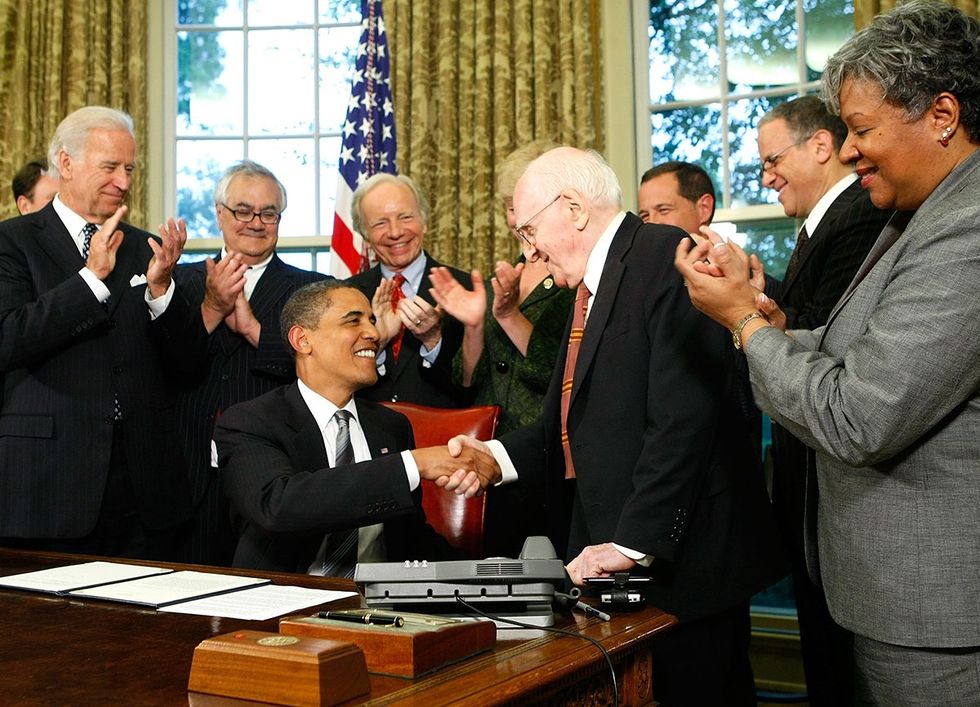
President Barack Obama shakes hands with Frank Kameny (3R) after signing a memorandum extend benefits to same-sex partners of federal employees as (background, from left) Vice President Joe Biden, U.S. Rep. Barney Frank, and U.S.Sen. Joseph Lieberman look on in the Oval Office of the White House, June 17, 2009.
Alex Wong/Getty Images
Frank Kameny, a pioneering LGBTQ+ rights advocate, would have turned 100 May 21. Kameny earned the moniker “Father of the Gay Rights Movement,” having become an activist after he lost his federal government job in the 1950s for being gay. Here and on the following pages are some key facts about Kameny, who will be honored Wednesday at a ceremony in front of the U.S. Supreme Court building.
He was born in 1925 into a middle-class Jewish family in New York City. Early on, he knew he wanted to be an astronomer. At age 16, he was already attending Queens College, majoring in physics. In 1943, just three days before his 18th birthday, he enlisted in the U.S. Army. During his induction, an officer asked him, “Do you have homosexual tendencies?” He said no, as did many gay men. Through an Army program, he took college courses at the University of Illinois in mechanical engineering. But he was sent overseas in 1944 and saw combat in a German-occupied section of Belgium.
He was discharged from the Army in 1946, finished his bachelor’s degree at Queens College, then attended Harvard University, where he earned a Ph.D. in 1956. He went on to teach at various colleges and universities.
Kameny’s academic career was short-lived, however. “In July 1957, while tensions between the Soviet Union and the US increased, the Army Map Service hired Kameny to create astronomical maps used to guide missiles,” says a bio on the National World War II Museum website. “Kameny enjoyed the work and was happy to have a career that was fulfilling and allowed him to continue to serve his country.”
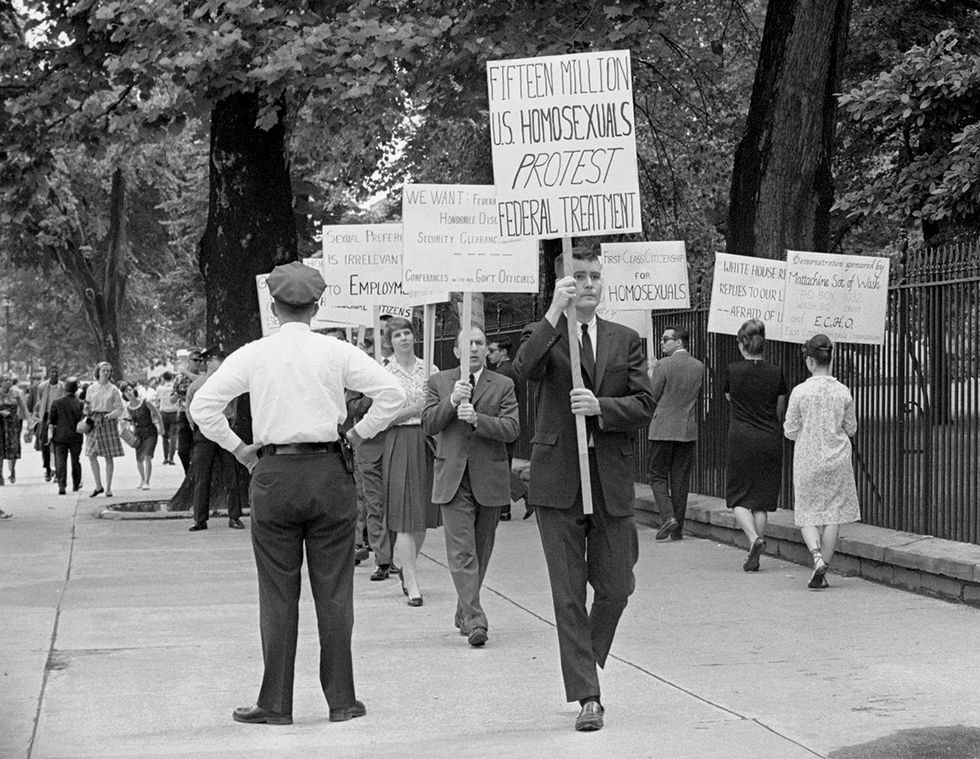
American gay rights activist Jack Nichols (center), followed by Frank Kameny and Lilli Vincenz, protesting with others outside the White House on Armed Forces Day, 1965. The demonstrators were protesting discrimination against gays in the military.
Bettmann Contributor/Getty Images
But he was soon fired for being gay. Officials at the Army Map Service found that Kameny had been arrested in 1956, before he was a federal employee, on charges of “lewd” conduct with another man in San Francisco, where he was attending a conference on astronomy, according to the World War II Museum bio. (A New York Times obituary of Kameny says he had been arrested in Washington, D.C.’s Lafayette Park, a gay cruising ground.)
He pleaded guilty to the San Francisco charges, paid a fine, and hoped the incident would not interfere with his career, the museum bio says. But the U.S. Civil Service Commission learned about at least one arrest, and the Map Service initiated an investigation. One investigator asked Kameny, “Information has come to the attention of the U.S. Civil Service Commission that you are a homosexual. What comment, if any, do you care to make?” Kameny wouldn’t answer.
The investigators concluded that he had lied when applying for a security clearance, as he reported an arrest for disorderly conduct, not “lewd.” The Map Service dismissed him and took away his security clearance, without which he couldn’t work for the federal government. Under a 1953 executive order by President Dwight D. Eisenhower, the government wouldn’t grant security clearances to gays and lesbians, with the excuse being that they could be blackmailed into giving out sensitive information — at a time when much of the U.S. was on the lookout for communist infiltration — but of course homophobia was at work as well. The ban on security clearances stood until 1995, when it was revoked by President Bill Clinton. Before that, however, some government agencies declined to enforce the ban, and the Civil Service Commission had ceased discriminating..
Kameny sued the Army for wrongful termination, but he lost. He went as far as asking the U.S. Supreme Court to hear his case, and it turned him down. “The government put its disqualification of gays under the rubric of immoral conduct, which I objected to,” Kameny told historian Eric Marcus years later. “Because under our system, morality is a matter of personal opinion and individual belief on which any American citizen may hold any view he wishes and upon which the government has no power or authority to have any view at all. Besides which, in my view, homosexuality is not only not immoral, but is affirmatively moral.” He made that argument in his petition to the Supreme Court. “Up until that time, nobody else ever said this — as far as I know — in any kind of formal court pleading,” he told Marcus.
He started to help other gay people prepare lawsuits to fight discrimination, and in 1961, he became president of the D.C. chapter of the Mattachine Society. In 1965, he led the first gay rights (the term “LGBTQ+ rights” would not enter the vocabulary for decades) protest at the White House, where he was joined by other pioneering activists, including Barbara Gittings and her partner, Kay Tobin Lahusen. The Rainbow History Project reenacted the protest this year on its 60th anniversary, April 17. The last surviving protester from 1965, Paul Kuntzler, marched in the reenactment. Another White House protest took place on Armed Forces Day in May 1965. Kameny also helped organize a protest at Independence Hall in Philadelphia on July 4, 1965, and those demonstrations were held annually through 1969.
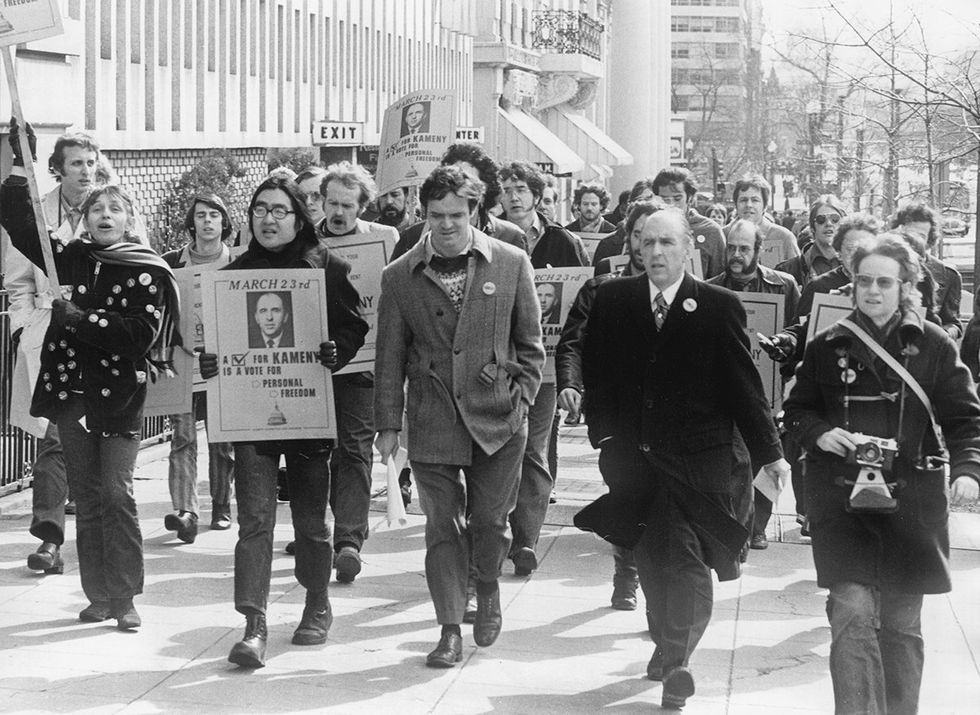
Frank Kameny (second from right) and supporters march to the White House on March 20, 1971, during his campaign for Congress. Kameny held a press conference in which he read a letter he had written to President Richard Nixon.
Robert Burchette/The Washington Post via Getty Images
In 1971, Kameny became the first out candidate for the U.S. House of Representatives. President Richard Nixon had signed a law the previous year giving D.C. a seat in the House as a nonvoting delegate. Local activists and federal employees, most of them closeted gay men, approached Kameny about running for the seat, and he agreed. In some ways he was an ideal candidate, notes public broadcaster WETA, as he was smart, articulate, and masculine-presenting. But he also was blunt, not prone to the evasions that often characterize political rhetoric. Still, he attracted many volunteers and substantial financial backing, including $500 from actor Paul Newman.
The Rev. Walter Fauntroy, a popular pastor and civil rights activist, was the Democratic nominee, so Kameny’s campaign gathered enough petition signatures to run him as an independent. His speeches were an early study in intersectionality, as he stressed the need for equal rights not only for gay people but for women and African Americans. His candidacy forced the media and other politicians to address gay rights, which Fauntroy began endorsing.
Fauntroy won the election easily, with Kameny coming in fourth out of six candidates. But Kameny’s run had an impact just the same. “The homosexual community must be freer now because of my candidacy,” he said on the night of the election.
Kameny, Gittings, Charles Silverstein, Jean O'Leary, and other activists helped persuade the American Psychiatric Association to remove homosexuality from its Diagnostic and Statistical Manual of Mental Disorders in the 1970s. A psychiatrist who attended the APA’s 1972 annual meeting in a mask as Dr. H. Anonymous, actually John Fryer, was key to the effort as well, telling attendees, “I am a homosexual. I am a psychiatrist.” The APA’s trustees approved the removal in December 1973, and the full membership ratified it the following year.
In 1977, Kameny was in a group of gay and lesbian activists who met with an aide to President Jimmy Carter at the White House — the first such White House meeting.
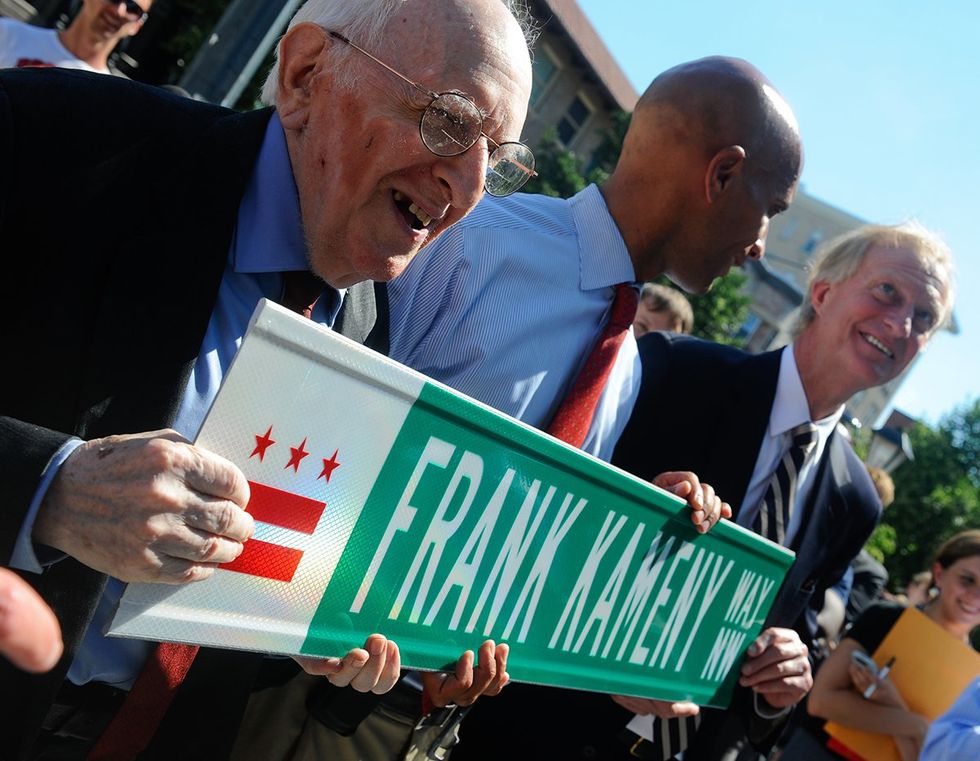
Mayor Adrian Fenty unveils a new street sign at 17th and R Streets NW dedicated to Frank Kameny. From left: Kameny, Mayor Fenty, and Jack Evans from Ward 2.
Sarah L. Voisin/The Washington Post via Getty Images
Years later, Kameny received many honors for his activism.
In 2009, when John Berry was sworn in as the director of the U.S. Office of Personnel Management, making him the highest-ranking out gay federal official in history, Kameny was his guest. Soon afterward, Berry issued a formal apology to Kameny on behalf of the government.
When Kameny died in 2011, Berry told The New York Times, “He helped make it possible for countless of patriotic Americans to hold security clearances and high government positions, including me.”
In 2015, Kameny was posthumously inducted into the U.S. Department of Labor’s Hall of Honor. “He will be forever thanked by LGBT government workers like me for helping usher in an age when we could serve openly, love who we love, and bring our full selves to our work,” Carl Fillichio, then senior adviser to the secretary of Labor and the highest-ranking out gay person in the department,” wrote in The Advocate at the time. “But more than that: The American people owe him a debt of gratitude as well. Were it not for his decades of advocacy, our country would be bereft of some of the sharpest minds and hardiest spirits overseeing the people’s business.”
In 2010, a street sign honoring Kameny was put up in D.C. His home in the district was designated as a D.C. Historic Landmark in 2009 and added to the National Register of Historic Places in 2011.
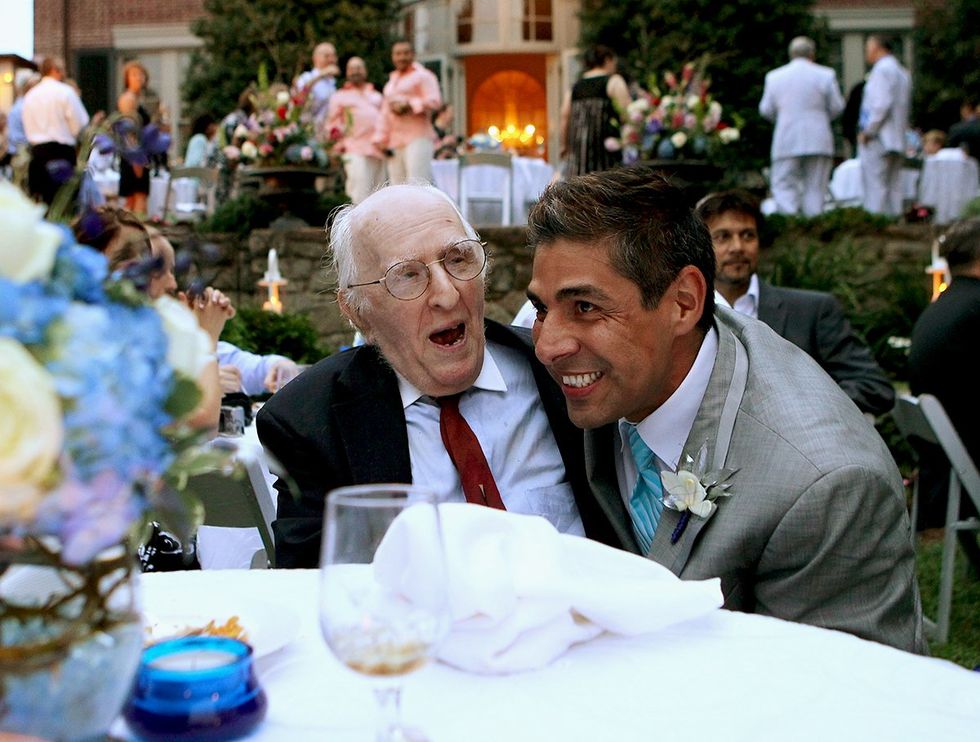
TV reporter Roby Chavez (right) shares a moment with Kameny during Chavez's wedding to Chris Roe, August 21, 2010, at the Woodrow Wilson House in Washington, D.C.
Alex Wong/Getty Images
At noon Wednesday, U.S. Rep. Ritchie Torres, U.S. Sen. Tammy Baldwin, marriage equality plaintiff Jim Obergefell, LGBTQ+ organizations, and other activists will commemorate Kameny’s centenary at a ceremony in from of the Supreme Court building. One hundred participants will light 100 candles. The event will also celebrate the 10th anniversary of Obergefell v. Hodges, the 2015 Supreme Court marriage equality decision.
“Frank Kameny was a strategic activist. He used picketing, politics, the courts, media, and pressure on the federal and municipal governments to fight for equality,” Malcolm Lazin, national chair of Kameny 100, said in a press release. “On the 10th anniversary of marriage equality, we’re honored to have as keynote speakers Jim Obergefell and Congressman Ritchie Torres, cochair, Congressional Equality Caucus.”
Collaborating national organizations include Advocates for Transgender Equality, the American LGBTQ+ Museum, Equality Forum, GLAAD, the Human Rights Campaign, Lambda Legal, LGBT History Month, LGBTQ+ Victory Fund, PFLAG, SAGE, and the Washington Blade.
Trudy Ring is The Advocate’s senior politics editor and copy chief. She has been a reporter and editor for daily newspapers and LGBTQ+ weeklies/monthlies, trade magazines, and reference books. She is a political junkie who thinks even the wonkiest details are fascinating, and she always loves to see political candidates who are groundbreaking in some way. She enjoys writing about other topics as well, including religion (she’s interested in what people believe and why), literature, theater, and film. Trudy is a proud “old movie weirdo” and loves the Hollywood films of the 1930s and ’40s above all others. Other interests include classic rock music (Bruce Springsteen rules!) and history. Oh, and she was a Jeopardy! contestant back in 1998 and won two games. Not up there with Amy Schneider, but Trudy still takes pride in this achievement.
Trudy Ring is The Advocate’s senior politics editor and copy chief. She has been a reporter and editor for daily newspapers and LGBTQ+ weeklies/monthlies, trade magazines, and reference books. She is a political junkie who thinks even the wonkiest details are fascinating, and she always loves to see political candidates who are groundbreaking in some way. She enjoys writing about other topics as well, including religion (she’s interested in what people believe and why), literature, theater, and film. Trudy is a proud “old movie weirdo” and loves the Hollywood films of the 1930s and ’40s above all others. Other interests include classic rock music (Bruce Springsteen rules!) and history. Oh, and she was a Jeopardy! contestant back in 1998 and won two games. Not up there with Amy Schneider, but Trudy still takes pride in this achievement.